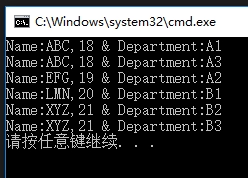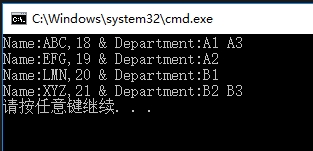C#中使用Join与GroupJoin将两个集合进行关联与分组
转自:https://www.cnblogs.com/cncc/p/7985843.html
对于Join的用法说明如下:
语法:
public static IEnumerable<TResult> Join<TOuter, TInner, TKey, TResult>(
this IEnumerable<TOuter> outer,
IEnumerable<TInner> inner,
Func<TOuter, TKey> outerKeySelector,
Func<TInner, TKey> innerKeySelector,
Func<TOuter, TInner, TResult> resultSelector
)
参数说明:
outer Type: System.Collections.Generic.IEnumerable<TOuter> 要联接的第一个序列。 inner Type: System.Collections.Generic.IEnumerable<TInner> 要与第一个序列联接的序列。 outerKeySelector Type: System.Func<TOuter, TKey> 用于从第一个序列的每个元素提取联接键的函数。 innerKeySelector Type: System.Func<TInner, TKey> 用于从第二个序列的每个元素提取联接键的函数。 resultSelector Type: System.Func<TOuter, TInner, TResult> 用于从两个匹配元素创建结果元素的函数。 返回值 Type: System.Collections.Generic.IEnumerable<TResult> IEnumerable<T> ,其类型的元素 TResult 通过对两个序列执行内部联接获得的。
参数类型:
TOuter 第一个序列中的元素的类型。 TInner 第二个序列中的元素的类型。 TKey 键选择器函数返回的键的类型。 TResult 结果元素的类型。
参考链接如下:
https://msdn.microsoft.com/zh-cn/library/bb534675.aspx
https://docs.microsoft.com/zh-cn/dotnet/api/system.linq.enumerable.join?f1url=https%3A%2F%2Fmsdn.microsoft.com%2Fquery%2Fdev15.query%3FappId%3DDev15IDEF1%26l%3DZH-CN%26k%3Dk(System.Linq.Enumerable.Join%60%604);k(TargetFrameworkMoniker-.NETFramework,Version%3Dv4.0);k(DevLang-csharp)%26rd%3Dtrue&view=netframework-4.7.1
例程:
using System;
using System.Collections.Generic;
using System.Linq;
namespace ConsoleApp33
{
class Program
{
static void Main(string[] args)
{
GroupJoinEx();
}
static void GroupJoinEx()
{
Person p1 = new Person() { Name = "ABC", Age = 18 };
Person p2 = new Person() { Name = "EFG", Age = 19 };
Person p3 = new Person() { Name = "LMN", Age = 20 };
Person p4 = new Person() { Name = "XYZ", Age = 21 };
List<Person> pList = new List<Person> { p1, p2, p3, p4 };
Department d1 = new Department() { Name = "A1", Employee = p1 };
Department d2 = new Department() { Name = "A2", Employee = p2 };
Department d3 = new Department() { Name = "A3", Employee = p1 };
Department d4 = new Department() { Name = "B1", Employee = p3 };
Department d5 = new Department() { Name = "B2", Employee = p4 };
Department d6 = new Department() { Name = "B3", Employee = p4 };
List<Department> dList = new List<Department> { d1, d2, d3, d4, d5, d6 };
var result = pList.Join(dList,
person => person,
department => department.Employee,
(person, department) => new
{
Person = person,
Department = department
});
foreach(var item1 in result)
{
Console.Write($"Name:{item1.Person} & Department:{item1.Department} ");
Console.WriteLine();
}
}
}
class Person
{
public string Name { set; get; }
public int Age { set; get; }
public override string ToString()
{
return $"{Name},{Age}";
}
}
class Department
{
public string Name { set; get; }
public Person Employee { set; get; }
public override string ToString()
{
return $"{Name}";
}
}
}
输出结果:

对于GroupJoin的用法说明如下:
语法:
public static IEnumerable<TResult> GroupJoin<TOuter, TInner, TKey, TResult>(
this IEnumerable<TOuter> outer,
IEnumerable<TInner> inner,
Func<TOuter, TKey> outerKeySelector,
Func<TInner, TKey> innerKeySelector,
Func<TOuter, IEnumerable<TInner>, TResult> resultSelector
)
参数说明:
outer Type: System.Collections.Generic.IEnumerable<TOuter> 要联接的第一个序列。 inner Type: System.Collections.Generic.IEnumerable<TInner> 要与第一个序列联接的序列。 outerKeySelector Type: System.Func<TOuter, TKey> 用于从第一个序列的每个元素提取联接键的函数。 innerKeySelector Type: System.Func<TInner, TKey> 用于从第二个序列的每个元素提取联接键的函数。 resultSelector Type: System.Func<TOuter, IEnumerable<TInner>, TResult> 用于从第一个序列的元素和第二个序列的匹配元素集合中创建结果元素的函数。 返回值 Type: System.Collections.Generic.IEnumerable<TResult> IEnumerable<T> ,其中包含类型的元素 TResult 通过对两个序列执行分组的联接获得的。
参数类型:
TOuter 第一个序列中的元素的类型。 TInner 第二个序列中的元素的类型。 TKey 键选择器函数返回的键的类型。 TResult 结果元素的类型。
参考链接如下:
https://msdn.microsoft.com/zh-cn/library/bb534297.aspx
https://docs.microsoft.com/zh-cn/dotnet/api/system.linq.enumerable.groupjoin?f1url=https%3A%2F%2Fmsdn.microsoft.com%2Fquery%2Fdev15.query%3FappId%3DDev15IDEF1%26l%3DZH-CN%26k%3Dk(System.Linq.Enumerable.GroupJoin%60%604);k(TargetFrameworkMoniker-.NETFramework,Version%3Dv4.0);k(DevLang-csharp)%26rd%3Dtrue&view=netframework-4.7.1
例程:
using System;
using System.Collections.Generic;
using System.Linq;
namespace ConsoleApp33
{
class Program
{
static void Main(string[] args)
{
GroupJoinEx();
}
static void GroupJoinEx()
{
Person p1 = new Person() { Name = "ABC", Age = 18 };
Person p2 = new Person() { Name = "EFG", Age = 19 };
Person p3 = new Person() { Name = "LMN", Age = 20 };
Person p4 = new Person() { Name = "XYZ", Age = 21 };
List<Person> pList = new List<Person> { p1, p2, p3, p4 };
Department d1 = new Department() { Name = "A1", Employee = p1 };
Department d2 = new Department() { Name = "A2", Employee = p2 };
Department d3 = new Department() { Name = "A3", Employee = p1 };
Department d4 = new Department() { Name = "B1", Employee = p3 };
Department d5 = new Department() { Name = "B2", Employee = p4 };
Department d6 = new Department() { Name = "B3", Employee = p4 };
List<Department> dList = new List<Department> { d1, d2, d3, d4, d5, d6 };
var result = pList.GroupJoin(dList,
person => person,
department => department.Employee,
(person, departments) => new
{
Person = person,
Department = departments.Select(d => d)
});
foreach(var item1 in result)
{
Console.Write($"Name:{item1.Person} & ");
foreach(var item2 in item1.Department)
{
if(item1.Department.First() == item2)
Console.Write($"Department:{item2} ");
else
Console.Write($"{item2} ");
}
Console.WriteLine();
}
}
}
class Person
{
public string Name { set; get; }
public int Age { set; get; }
public override string ToString()
{
return $"{Name},{Age}";
}
}
class Department
{
public string Name { set; get; }
public Person Employee { set; get; }
public override string ToString()
{
return $"{Name}";
}
}
}
输出结果:

以上代码仅在Join与GroupJoin最后一个参数有区别,可以参见红色字体部分,
并从以上结果来看,Join与GroupJoin的区别一个在于:Join仅仅是将两个结合进行关联,而GroupJoin则会进行分组。
“fool me once,shame on you. fool me twice, shame on me.”,翻译过来的意思是“愚弄我一次,是你坏;愚弄我两次,是我蠢”。







【推荐】国内首个AI IDE,深度理解中文开发场景,立即下载体验Trae
【推荐】编程新体验,更懂你的AI,立即体验豆包MarsCode编程助手
【推荐】抖音旗下AI助手豆包,你的智能百科全书,全免费不限次数
【推荐】轻量又高性能的 SSH 工具 IShell:AI 加持,快人一步
· 开发者必知的日志记录最佳实践
· SQL Server 2025 AI相关能力初探
· Linux系列:如何用 C#调用 C方法造成内存泄露
· AI与.NET技术实操系列(二):开始使用ML.NET
· 记一次.NET内存居高不下排查解决与启示
· 阿里最新开源QwQ-32B,效果媲美deepseek-r1满血版,部署成本又又又降低了!
· 开源Multi-agent AI智能体框架aevatar.ai,欢迎大家贡献代码
· Manus重磅发布:全球首款通用AI代理技术深度解析与实战指南
· 被坑几百块钱后,我竟然真的恢复了删除的微信聊天记录!
· AI技术革命,工作效率10个最佳AI工具